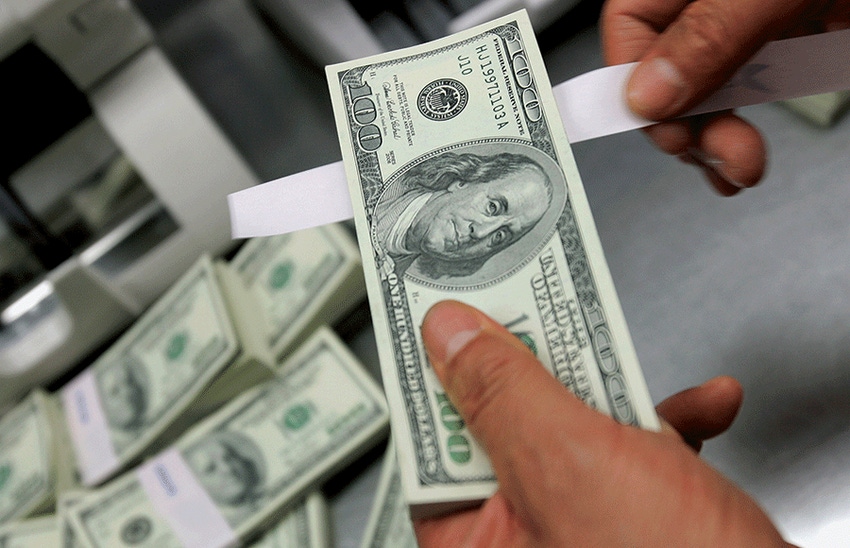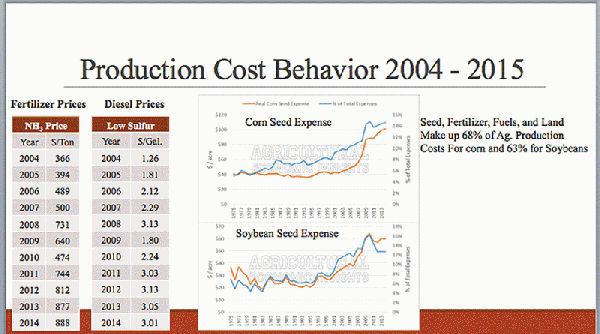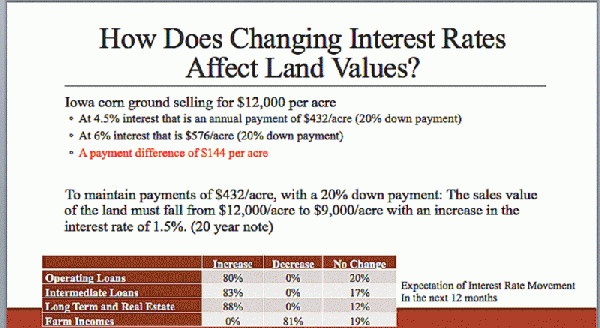
This year “isn’t looking very promising” for many Mississippi producers, Bryon Parman said at the annual meeting of the Mississippi Agricultural Economics Association. “We’re seeing producers dip into cash reserves they’ve built up over the past decade.”

BRYON PARMAN
With continuing high production costs and commodity prices significantly lower than previous years — using cash rental rates of $191 for top quality ground, $150 for lower quality land — many of the state’s farmers will likely have negative returns from this year’s crops, he says.
“Farmers who were cash flowing when corn was $6.50 to $7 and soybeans $13 to $14 are no longer cash flowing — in fact, they’re taking significant losses in a lot of cases, particularly in U.S. regions where land rental rates were as high as $350-$400 per acre. In the Mississippi Delta this year, the average cash rental rate was $190 to $195 per acre, significantly less than other areas, but fairly high when compared to four or five years ago.”
Stay informed on what’s happening in Mid-South agriculture: Subscribe to Delta Farm Press Daily.
Parman, who is assistant Extension professor of economics at Mississippi State University, says MSU budgets, using a rental rate of $191 per acre and a ballpark insurance premium of $14 per acre, calculate the breakeven for 200 bushel corn somewhere around the $4.50 mark.

Burke Fisher, from left, Kirk Land & Realty, Indianola, Miss.; Bob Stark, Jr., agricultural economist, University of Arkansas-Monticello; and Barry Barnett, professor of agricultural economics at Mississippi State University, were among participants in the annual meeting of the Mississippi Agricultural Economics Association.
“Right now, corn is around $3.90, which would give a loss of $122 per acre under optimal growing conditions. There was a two-week period this summer when corn prices were up around $4.50. My hope is that a lot of producers were able to forward contract a lot of this year’s crop at that price.”
The figures for soybeans “aren’t quite as bad,” he says, “but with a target yield of 65 bushels, the Delta breakeven is $9.50 to $9.75 per bushel, based on the $191 per acre cash rental rate. Some farmers are able to produce at lower costs than this, so their breakeven will be a bit lower. But others are producing at higher costs, so their losses will be even more significant than I’m showing.”
The breakeven for cotton, with the $191 cash rental rate, is about 95 cents per pound. That’s for lint only, he says, and doesn’t include cottonseed, oil, or other returns.
Little relief on horizon
The projection for commodity prices by the Food and Agricultural Policy Research Institute (FAPRI) for the next three to five years is for corn at $3.50 to $4.25; soybeans $9.25 to $10.50; and wheat $5.10 to $6.10, Parman says. “Much of that is based on there being record levels of ending stocks, crop production expectations, etc. — basically, that there won’t be much relief in terms of commodity prices.
“All this could take net farm income down to about where it was in 2005, a significant drop from 2013, which had the highest net farm income over the past 20 years. About the only possibility on the horizon to ease some of the pain would be a reduction in input costs.”
That has not been the case in recent years, Parman says.

Seed, fertilizer, fuels, and land make up 68 percent of ag production costs for corn, and 63 percent for soybeans.—Bryon Parman
USDA’s National Agricultural Statistics Service figures show U.S. farm income between 2007 and 2012 went up 76.6 percent. “For a time, commodity prices were outpacing production cost increases, helping buffer farm income, but production costs moved up, too, rising 36.4 percent. Right now, although commodity prices are trending down, production costs aren’t going down as much.”
Fertilizer prices — a big expense for farmers, particularly for corn — increased from $366 per ton in 2004 for NH3 to $888 in 2014. “I know farmers use different types of nitrogen, but it all basically starts with NH3, and that pretty much drives the price for everything else. For corn, fertilizer can represent as much as 30 percent of all production costs.
“Diesel was $1.26 per gallon in 2004; last year’s average was around $3 per gallon. Seed costs increased dramatically during the period — for corn and soybeans, seed costs went up well over 100 percent. Seed, fertilizer, fuels, and land make up 68 percent of ag production costs for corn, and 63 percent for soybeans.”
From 2004 to 2014, net farm income tracked upward with the increase in land values, Parman says. “Net cash income and net farm income were dramatically higher from 2004/06 through 2013, but they’ve had a straight downward track over the last couple of years. One of the biggest reasons incomes have been on such a steep downward slope is that, while commodity prices have fallen significantly, fertilizer, land, seed, and fuel prices have not.”
Some farms won't cash flow
The Federal Reserve Bank of Minneapolis reported in 2014 that farmland values “had pretty much stabilized — which is pretty much what we were seeing in Mississippi,” he says. “Some Iowa farmland values were down 9 percent, the largest single drop since the 1980s. Cash rents were down some, but not enough, based on commodity prices. A lot of people signed rental agreements for three to five years, so they’re stuck with paying rents that won’t cash flow. In some cases, they paid cash rent for three years in advance and financed that; now, they’re trying to pay it back with commodity prices that won’t support it.”

As a percentage of total expenditures, producers have enjoyed favorable lending conditions that reduced the burden of interest on production costs.—Getty Images/Joe Raedle
Most farmers are comfortable with the idea, Parman says, that the amount of revenue generated by a piece of farmland drives the value of that asset up or down, depending on how well they’re doing. “Another important factor is interest rates, the ability to finance that farm ground. This is something that has been overlooked in a lot of trade magazines and research — not only how interest rates created something of a perfect storm of high commodity prices and cheap money that drove farmland values to the highest levels we’ve seen, but where interest rates are going to go in the next five years.”
Rates have fallen dramatically in the last 10 years, he notes, from 5 percent in 2005 to 2 percent in 2015, using the real value of T-bills as a benchmark. “As a percentage of total expenditures, producers have enjoyed favorable lending conditions that reduced the burden of interest on production costs,” Parman says. “As a percentage of total expenses, historically low interest rates became essentially a rounding error for a lot of farmers — in some cases, farmers were actually able to dictate lending terms as banks competed to lend money to them.”
Current interest rates being offered by Mississippi lenders, he says, average 4.1 percent for variable rate operating, intermediate, long term, and real estate loans, and 4.6 percent to 5.1 percent for fixed interest rate loans. “Similar rates were reported by the St. Louis Federal Reserve agricultural lenders survey. That’s fairly low, when placed in the historical context of 7 percent to 8 percent.”
Interest rate impact on land
How do changing interest rates affect land values? Using a $12,000 per acre average for Iowa corn ground, an increase from 4.5 percent to 6 percent would mean a payment difference of $144 per acre, Parman says. “That makes a world of difference between whether you’re anywhere close to breaking even or you’re losing money. In this case, with current operating costs and revenues generated, it would be a pure loss. The sales value of the land would need to fall to $9,000 per acre — almost 25 percent — just to offset the 1.5 percent increase in interest rate.”

“Interest rate can make a world of difference between whether you’re anywhere close to breaking even or you’re losing money."—Bryon Parman
The expectation by Mississippi lenders, he says, “was almost universally for an increase or no change in interest rate, and their expectation for farm income was pretty dismal. We could probably all agree that interest rates right now are about as low as they’re going to go. With falling commodity prices, there’s not much direction for interest rates to go but up.”
Farmer debt-to-equity and debt-to-asset ratios in the 1980s were “a lot worse” than today, Parman says. “The financial farm solvency situation was much less favorable than now. In the last 10 years, farmers have been able to pay for a lot of their land with cash. Farmers who have been doing well will probably continue to do all right, despite the downturn we’re seeing now and expecting in the future.
“But, those who are just getting by year-to-year and loan-to-loan, trying to make payments — the young farmers, the new farmers, the up-and-comers, who rented a lot of ground and signed a lot of contracts and don’t have a lot of assets to fall back on — may be in for some stressful times financially.”
About the Author(s)
You May Also Like




